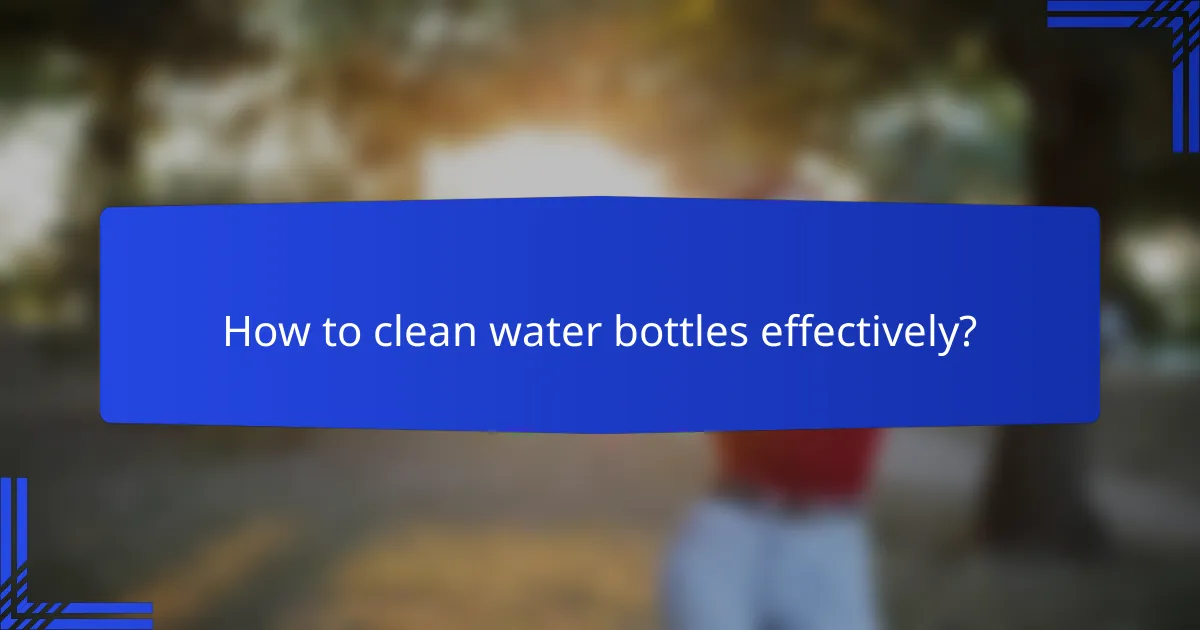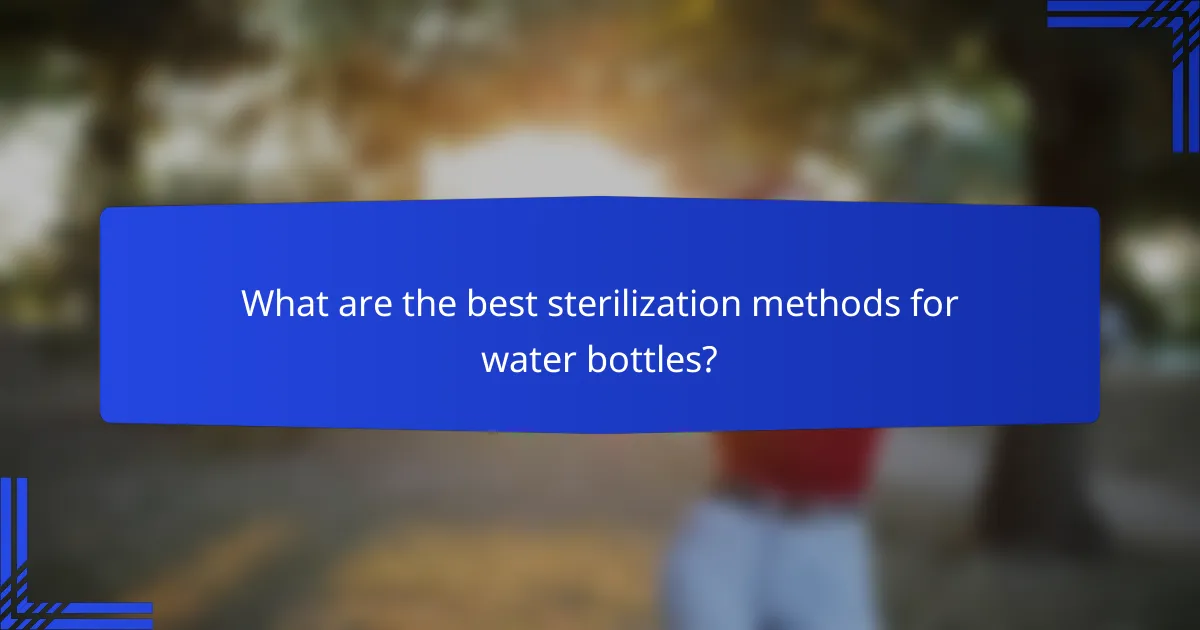Keeping your water bottles clean and sanitized is crucial for ensuring safe hydration. Effective cleaning methods and proper sterilization techniques can eliminate harmful bacteria and odors, while appropriate storage practices help maintain their integrity and longevity. By following these guidelines, you can enjoy fresh, clean water from your bottles every time.

How to clean water bottles effectively?
Cleaning water bottles effectively involves using the right methods and tools to ensure they are free from bacteria and odors. Regular cleaning with appropriate materials can prolong the life of your bottle and maintain the quality of the water you drink.
Use warm soapy water
Using warm soapy water is one of the simplest and most effective methods for cleaning water bottles. Fill the bottle with warm water and add a few drops of dish soap, then shake it vigorously to create suds. Let it soak for a few minutes before rinsing thoroughly.
For best results, use a mild dish soap that is free from harsh chemicals. Avoid using bleach or other strong cleaners, as they can leave harmful residues.
Utilize vinegar and baking soda
Vinegar and baking soda create a natural cleaning solution that effectively removes stains and odors from water bottles. Pour a mixture of equal parts vinegar and water into the bottle, then add a tablespoon of baking soda. The reaction will help lift grime and disinfect the surfaces.
Let the mixture sit for about 15-30 minutes before rinsing it out. This method is particularly useful for bottles that have been used for flavored drinks or have developed a persistent smell.
Employ bottle brushes
Using a bottle brush is essential for reaching the bottom and sides of your water bottle, especially if it has a narrow neck. A long-handled brush allows you to scrub away any residue that may not be removed by soaking alone.
Choose a brush with soft bristles to avoid scratching the interior of the bottle. Regular use of a bottle brush can help maintain cleanliness and prevent buildup.
Consider dishwasher-safe options
If convenience is a priority, consider using dishwasher-safe water bottles. Many modern bottles are designed to withstand the heat and pressure of a dishwasher, making cleaning effortless.
Check the manufacturer’s guidelines to ensure your bottle is dishwasher-safe, and place it on the top rack to avoid damage. This method can save time and ensure thorough cleaning.
Rinse thoroughly after cleaning
After cleaning your water bottle, it is crucial to rinse it thoroughly to remove any soap, vinegar, or baking soda residues. Residual cleaning agents can affect the taste of your water and may even be harmful if ingested.
Rinse with clean, warm water several times until you no longer detect any cleaning solution. Allow the bottle to air dry completely before storing it to prevent moisture buildup, which can lead to mold growth.

What are the best sterilization methods for water bottles?
The best sterilization methods for water bottles include boiling water, sterilizing tablets, microwave sterilization, and UV-C sterilization devices. Each method has its own advantages and considerations, making it essential to choose one that fits your needs and circumstances.
Boiling water method
The boiling water method involves submerging the water bottle in boiling water for several minutes to kill bacteria and viruses. Ensure the bottle is made of heat-resistant material to avoid damage. Typically, boiling for 5-10 minutes is sufficient for effective sterilization.
Before boiling, clean the bottle with soap and water to remove any residue. After boiling, allow the bottle to cool before handling, and ensure it is completely dry before storage to prevent mold growth.
Use of sterilizing tablets
Sterilizing tablets are a convenient option for disinfecting water bottles, especially when traveling. These tablets usually contain chlorine or iodine and dissolve in water, creating a solution that kills pathogens. Follow the manufacturer’s instructions for the correct dosage and soaking time, which typically ranges from 30 minutes to a few hours.
Rinse the bottle thoroughly after using sterilizing tablets to remove any chemical residue. This method is effective and requires no special equipment, making it accessible for most users.
Microwave sterilization
Microwave sterilization can be effective for certain types of water bottles, particularly those made of microwave-safe materials. Fill the bottle with water, leaving some space at the top, and microwave it for about 2-5 minutes. The steam generated will help kill germs inside the bottle.
Be cautious with this method, as not all bottles are microwave-safe. Always check the manufacturer’s guidelines before using this method to avoid damaging the bottle or causing safety hazards.
UV-C sterilization devices
UV-C sterilization devices use ultraviolet light to eliminate bacteria and viruses in water bottles. These devices are portable and easy to use; simply place the UV-C light inside the bottle and activate it for a few minutes. This method is chemical-free and effective against a wide range of pathogens.
Consider the size and battery life of the UV-C device when choosing one. While this method is highly effective, it may require a higher initial investment compared to other sterilization methods.

How to store water bottles properly?
Proper storage of water bottles is essential to maintain their cleanliness and functionality. Storing them correctly helps prevent contamination and prolongs their lifespan.
Keep in a cool, dry place
Storing water bottles in a cool, dry location helps prevent the growth of bacteria and mold. Ideal storage temperatures are typically between 15°C and 25°C (59°F to 77°F).
Avoid places with high humidity, such as bathrooms or near stoves, as moisture can lead to unwanted microbial growth inside the bottles.
Avoid direct sunlight exposure
Direct sunlight can degrade the materials of water bottles, especially those made from plastic. UV rays can cause harmful chemicals to leach into the water, making it unsafe to drink.
Store your bottles in shaded areas or inside cabinets to protect them from sunlight. This practice not only preserves the integrity of the bottle but also keeps the water cooler.
Store upright to prevent leaks
Storing water bottles upright minimizes the risk of leaks and spills. When bottles are laid on their sides, the lids may loosen or become damaged, leading to potential leaks.
Using a dedicated shelf or container for upright storage can help keep your bottles organized and secure, reducing the chances of accidents.
Use dedicated storage containers
Using dedicated storage containers for your water bottles can help keep them clean and organized. Choose containers that are easy to clean and made from materials that won’t retain odors.
Consider using bins or racks specifically designed for water bottles, which can help maximize space and ensure that bottles are stored safely and accessibly.

What are the common materials used in water bottles?
Water bottles are typically made from materials like stainless steel, BPA-free plastic, and glass. Each material has its own advantages and considerations, influencing factors such as durability, safety, and ease of cleaning.
Stainless steel
Stainless steel water bottles are known for their durability and resistance to rust and corrosion. They are often insulated, keeping beverages hot or cold for extended periods, making them ideal for outdoor activities.
When choosing stainless steel bottles, look for those that are food-grade and free from harmful chemicals. Regular cleaning with mild soap and water is recommended to maintain their appearance and hygiene.
BPA-free plastic
BPA-free plastic bottles are lightweight and often more affordable than their metal or glass counterparts. They are designed to be safe for food and drink, avoiding the harmful effects associated with bisphenol A (BPA).
However, plastic bottles can retain odors and stains over time. To prolong their lifespan, clean them regularly and avoid exposure to high temperatures, which can degrade the material.
Glass
Glass water bottles are favored for their purity and lack of chemical leaching. They do not retain flavors or odors, making them a great choice for those who prefer a clean taste.
While glass bottles are generally heavier and more fragile than plastic or stainless steel, they can be very stylish and eco-friendly. Ensure to use a protective sleeve if you plan to carry them frequently to avoid breakage.
